Outdoor Learning Practice Inspiration
In order to provide ideas for ‘practice inspiration’ surrounding Outdoor Learning, this section will offer insights into the innovative practice at Torryburn Nursery.
This short article contains useful information about the ethos, activities, and resources Torryburn staff draw upon to support children’s outdoor learning.
Torryburn Nursery
At Torryburn, we recognise that we are in a unique situation to offer high-quality outdoor experiences to our children. On our doorstep and within walking distance we have a diverse range of environments: a community garden opposite the school, a beach that looks across the river forth, and a woodland with a burn flowing through it.
We realise that whilst we are lucky to have these special spaces in our local environment, we also have a duty to use them to their full potential. Staff recognise that these spaces can give children an amazing range of experiences.
Community Garden
Nursery staff have fostered a wonderful relationship with the committee that maintain the garden. We had ‘Zoom’ meetings with the committee where the children were able to ask questions and seek permission to plant bulbs in the wider garden and shared plans for raised beds.
The committee have secured grants to renovate the space. This has resulted in the garden becoming a safe environment for the nursery to access. Our staff recognise that this space can offer children a range of experiences that are both child and adult initiated.
We visit the garden every Tuesday without fail, morning and afternoon. This means that children can experience the garden throughout the seasons. We have three raised beds for nursery use, which means that we can offer planting experiences.
As we are now open throughout the year, rather than only term-time, we can plant fruit, vegetables, and flowers that will emerge at different times. Watching our them grow has been exciting.
Some children prefer to use the space to run free. There is a hill that staff encourage children to run-up ad down freely. This strengthens muscles and builds co-ordination.
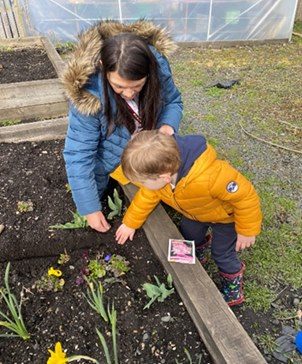
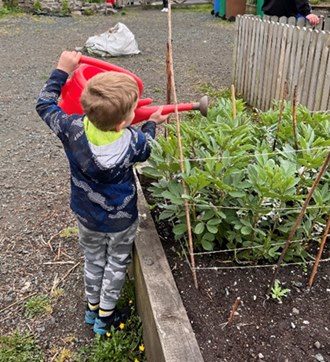
The Woods
We visit our local woodland every week. The only times we don’t are when it is extremely windy. Each week, we take turns to read out the ‘rules.’ Children enjoy taking leadership roles. They also take turns carrying the backpack which contains paper, pens, bug finders, nets, and pots. We make sure that adults are spaced across the areas so that children can choose where to explore.
There is a fallen tree that we call the ‘Gruffalo Tree.’ We climb on this. Then, as we grow in confidence, we crawl along it. As our balance increases, we walk along.
The burn can be difficult to access, so we use our gross motor skills to carefully climb down to it. We use yoghurt tubs for pond dipping and to discover the creatures around us.
We cross the burn by navigating from one rock to another. This can help develop our early numeracy skills. “Is the rock close enough?” “Is it flat enough for me to stand on?” “Will it take my weight?” Sometimes we get it wrong and end up getting wet! This builds our resilience. We need to cross one person at a time, so need to be patient as some people take longer than others to cross. Here, we can learn cooperative skills.
There are trees in the woods that we like to climb. Children feel a tremendous sense of achievement when they try and succeed, when others support them to persevere, and praise them for their achievements no matter how small. This can help build our strength and resilience.
As adults, if we are able, often take for granted the ability to get to where we want, pick up what we need, avoid hazards, and move cooperatively with others in games or traffic. But these skills take a long time, and a lot of practice to develop. This is why observations of children’s actions are crucial to inform our practice and ensure it is developmentally appropriate. The best way to help babies and young children develop these skills is through providing daily opportunities for physical play.” (RTA).
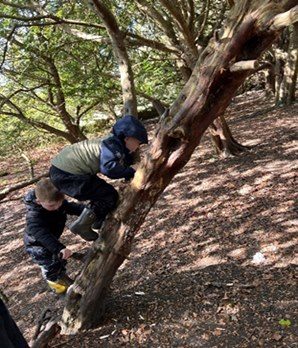
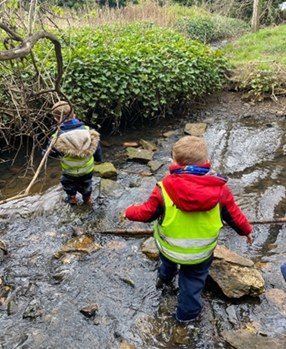
Beach
We use the beach for lots of different activities, including: learning about science through floating and sinking, running and walking on different and changing surfaces, discovering crabs and shells, and spotting oyster catchers, seagulls, and curlews.
At the beach, we can take our buckets and collect ‘treasure’ to take home and share with our family. These found objects, both natural and manmade can be used to create beautiful transient art.
Sometimes, on our way back from the woods, we stop for a ‘gentle look’ across the water and a paddle. In the afternoon, as the sun begins to set, it is a wonderful place for contemplation, and a great place to spend time in the moment taking notice of our environment.
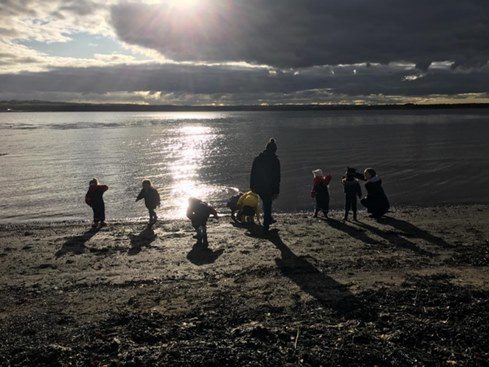
The NHS ‘5 Ways to Wellbeing’ reminds us to ‘take notice’, like we do at Torryburn on our walks:
- Being curious.
- Catching sight of the beautiful.
- Remarking on the unusual.
- Noticing the changing seasons.
- Savouring the moment.
- Being aware of the world around us and what we are feeling.
- Reflecting on our experiences and appreciating what matters to us.
Try encouraging children in your setting to ‘take notice’ in the outdoors.

